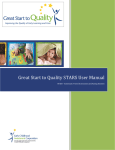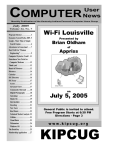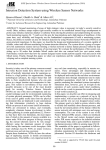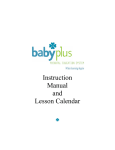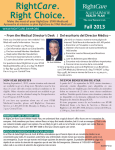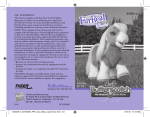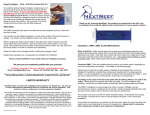Download 4-C Voice for Children - Community Coordinated Child Care
Transcript
September/October 2010 Volume 30, Issue 5 4-C Voice for Children Published by Community Coordinated Child Care 1215 South Third Street, Louisville, KY 40203 502-636-1358 www.4cforkids.org Text4baby by Susan Vessels, 4-C Executive Director In This Issue ow many times have you heard H Text4baby is a large, public-private parents say, “There should be a partnership that includes corporations user manual that comes with kids?” like Johnson & Johnson, Pfizer, and MTV as well as governmental organiza- Public Policy Page 2 Being There for Children Page 3 4-C Trainings Highlighted Page 4 Fun Ideas & Activities Page 5 Voice for Children Membership Page 6 Well, we don’t quite have a user tions including the White House Office of manual but there is a pretty cool new Science and Technology and the Dept. of tool that gives pregnant women and Health and Human Services. new moms information on caring for themselves and their new baby. There are no fees or strings attached so, spread the word. Text4baby is like Text4baby is a free mobile informa- having your mom or best friend close at tion service in which women who sign hand to give you advice about what to up for the service by texting BABY to expect during your pregnancy and the 511411 (or BEBE in Spanish) will first year of being a mom. receive free SMS text messages each week, timed to their due date or baby’s We’ll keep our eyes open for that user date of birth. manual. Healthy Child Care Parent Page Inserts For over 40 years, 4-C has been the central point of contact for our community’s child care needs. 4-C is a private, non-profit Metro United Way agency dedicated to improving the quality, availability, and accessibility of child care and early childhood development programs in the Kentuckiana area. Public Policy Save These Dates! Two Upcoming Blueprint for Kentucky’s Children Events The 7th Annual Children’s Advocacy Day at the Capitol Step Up for Kids Conference Tuesday, October 5, 2010 at The Gheens Academy 4425 Preston Highway Louisville, KY 40213 from 9:00 a.m. - 4:30 p..m. Cost: Free, including lunch Advocates from across Kentucky will gather in Louisville for the Step Up for Kids Conference to celebrate National Step Up for Kids Day, to introduce the 2011 Blueprint for Kentucky’s Children Agenda, and to prepare for the 7th Annual Children’s Advocacy Day at the Capitol. Thursday, February 17, 2011 at Capitol Rotunda Frankfort, KY Registration begins at 9:00 a.m. on the second floor. Rally begins at 10:00 a.m. in the Rotunda. Cost: Free Mark your calendars for the 7th Annual Children’s Advocacy Day at the Capitol! Doctors, teachers, public health experts, elected officials, members of the military, seniors, and kids will all come together around the 2011 Blueprint for Kentucky’s Children Agenda to tell legislators that it’s time to invest in Kentucky’s youth! Register for the Step Up for Kids Conference and/or the 7th Annual Children’s Advocacy Day at the Capitol today at the 4-C website www.4cforkids.org 4-C Voice for Children September/October 2010 Page 2 Being There for Young Children entering the profession) through meetings, workshops, and conferences. You can share your knowledge of young children and appropriate practices with parents (and others who are entering the profession) through meetings, workshops, and conferences. A great part of being a professional in early childhood education is the fact that, with our education, on-the-job training, and hands-on experiences, we become ‘experts’ in knowing what young children, and often their families, need. This knowledge carries with it the responsibility to be advocates for young children, their families, and quality child care programs. What is an ADVOCATE? The dictionary lists several ‘heroic’ words--words that we might not have associated with ourselves or with the work we do. An advocate is a defender of something, such as good child care; a supporter, such as children’s rights; and intercessor, maybe between children and abuse; someone who aids others, such as young children and their families. An advocate is a courageous person who speaks out about issues that affect our own working conditions, as well as children’s learning environments. Advocacy implies that we use our own resources and knowledge to take action. We work for change. As professional early childhood educators, we must first let others know that “we ARE professionals; we are not ‘baby sitters.” We have studied the growth and development of children from birth to age 5 (or even age 8). We know what is developmentally appropriate for each child. We get to know individual children and give them care and education that is just right for each one of them. We know that what we do is important to families and we must speak out for the early childhood profession. Here are some ways you can do this: You can share your knowledge of young children and appropriate practices with parents (and others who are 4-C Voice for Children September/October 2010 You can share your professional experiences and anonymous examples with other community organizations and with decision makers to let them know what help children and families need. We can represent this group of citizens so they are more than just statistics to those who make the laws. You can write to state or federal legislators about the need for funding early childhood education so that both children and educators get what they need. Sign up for Parent Voice so you can stay up to date on issues that affect early childhood education. Go to http:// www.parent voice.org/. You can join an early childhood professional group such as NAEYC or 4-C, so that our voice becomes stronger in numbers. You can interact with the local school boards and kindergarten teachers, in particular, to help them understand what we do in early childhood education. You can write letters to the editor of a newspaper or magazine to respond to articles about young children and their families so that our experiences make the information truthful and valid. You can help those in the child care profession by become CDA Advisors when you get your own credentials, and contributing your help to new programs starting up in the community. As professional early childhood educators, we need to be visible and helpful to make people aware of the important work we do. We have a vision for our work and can truly make a difference in the world of the young child. Let’s be there for children! - Adapted from Everyday TLC by Kathy Faggella Page 3 Need Child Care Training? Highlights of 4-C Trainings Coming to A Location Near You September 9 (6:00-9:00 PM) Stony Brook/Jeffersontown Area Say What? - Learn how to tweak your communication skills the positive way. October 14 (6:00-9:00 PM) Stony Brook/Jeffersontown Area Hand Mitt Stories - Participants will assemble a story mitt to promote and enhance story time. September 18 (8:00 AM-3:15 PM) Sullivan University 4-C Forum - Experience a professional conference with a wide variety of topics and earn up to 6 hours of training credit. October 6 & 20 (6:00-9:00 PM) Downtown Area at 4-C Creating a Positive Professional Work Environment Mini-Series - Explore characteristics of a positive work environment while engaging in activities that promote professionalism and positive work behaviors. (Earn 9 credit hours by attending both classes, and completing an assignment.) October 16 (8:30 AM-3:30 PM) Explaining Play to Parents by Making Learning Visible - Help parents understand the importance of play by making learning visible. October 30 (8:30 AM-3:30 PM) Finding the Right Fit...Succession Planning Hire for attitude, train for skill, and move your team to the next level. September 13 & 20 (6:00-9:00 PM) Downtown Area at 4-C It Takes More Than Pine Cones...Mini-Series Learn how to turn your discovery center into a dynamic hub of activity. (Earn 9 credit hours by attending both classes, and completing an assignment.) September 21 (6:00-9:00 PM) Oldham Co. Area Exploring Toddlers Behavior - Explore toddlers needs and how to avoid unwanted behaviors by examining the appropriate/inappropriate behavior. October 19 (6:00-9:00 PM) Oldham Co. Area It’s All in the Plan - Your day will run easier, the children will be happier and your stress level will fall...as long as you have a lesson plan. 12345678901234567890123456789012123456789012345678901234567890121234567890123456789012345678901212345678901234567890123 12345678901234567890123456789012123456789012345678901234567890121234567890123456789012345678901212345678901234567890123 12345678901234567890123456789012123456789012345678901234567890121234567890123456789012345678901212345678901234567890123 12345678901234567890123456789012123456789012345678901234567890121234567890123456789012345678901212345678901234567890123 12345678901234567890123456789012123456789012345678901234567890121234567890123456789012345678901212345678901234567890123 12345678901234567890123456789012123456789012345678901234567890121234567890123456789012345678901212345678901234567890123 12345678901234567890123456789012123456789012345678901234567890121234567890123456789012345678901212345678901234567890123 12345678901234567890123456789012123456789012345678901234567890121234567890123456789012345678901212345678901234567890123 12345678901234567890123456789012123456789012345678901234567890121234567890123456789012345678901212345678901234567890123 12345678901234567890123456789012123456789012345678901234567890121234567890123456789012345678901212345678901234567890123 12345678901234567890123456789012123456789012345678901234567890121234567890123456789012345678901212345678901234567890123 12345678901234567890123456789012123456789012345678901234567890121234567890123456789012345678901212345678901234567890123 12345678901234567890123456789012123456789012345678901234567890121234567890123456789012345678901212345678901234567890123 12345678901234567890123456789012123456789012345678901234567890121234567890123456789012345678901212345678901234567890123 12345678901234567890123456789012123456789012345678901234567890121234567890123456789012345678901212345678901234567890123 12345678901234567890123456789012123456789012345678901234567890121234567890123456789012345678901212345678901234567890123 12345678901234567890123456789012123456789012345678901234567890121234567890123456789012345678901212345678901234567890123 12345678901234567890123456789012123456789012345678901234567890121234567890123456789012345678901212345678901234567890123 12345678901234567890123456789012123456789012345678901234567890121234567890123456789012345678901212345678901234567890123 12345678901234567890123456789012123456789012345678901234567890121234567890123456789012345678901212345678901234567890123 12345678901234567890123456789012123456789012345678901234567890121234567890123456789012345678901212345678901234567890123 12345678901234567890123456789012123456789012345678901234567890121234567890123456789012345678901212345678901234567890123 12345678901234567890123456789012123456789012345678901234567890121234567890123456789012345678901212345678901234567890123 12345678901234567890123456789012123456789012345678901234567890121234567890123456789012345678901212345678901234567890123 12345678901234567890123456789012123456789012345678901234567890121234567890123456789012345678901212345678901234567890123 12345678901234567890123456789012123456789012345678901234567890121234567890123456789012345678901212345678901234567890123 12345678901234567890123456789012123456789012345678901234567890121234567890123456789012345678901212345678901234567890123 12345678901234567890123456789012123456789012345678901234567890121234567890123456789012345678901212345678901234567890123 To register online for any of these workshops, go to www.4cforkids.org or send in a registration form from the 4-C Professional Development Calendar along with payment. For more information, call 618-5156. 4-C Voice for Children September/October 2010 Page 4 Fun Ideas & Activities Paper Capers T hese concoctions focus on fabulous fibers. Gather them from old newspaper, greeting cards, and even egg cartons. Recycle them into handsome, handmade paper. Mash them into paper-mache creatures. See for yourself what the fibers in crepe paper, napkins, and even toilet paper are like to mold! What’s paper made of? Tear a piece and see. Look closely at the torn edge. It looks sort of hairy, doesn’t it? These hairs are plant fibers-the same as those that make a plant’s roots, leaves, and stems strong. Next time you doodle on a notepad, think about how you are drawing on top of millions of plant fibers. That’s how many it takes to make a sheet of paper. What keeps those millions of tiny fibers from falling apart? Ah, that’s the wonderful thing about cellulose, the special substance plant fibers are made of. Cellulose fibers stick to each other very easily. It’s this sticking trait that cause them to mat together into a sheet of paper when water is added to them. Then, when you take the water away by drying, almost magically the bond becomes even stronger. Tug at the sides of a dry sheet of paper; it’s amazingly strong, isn’t it? It’s almost impossible to pull those fibers apart. Mash Here is a popular concoction for a basic mash. What You Need Newspapers Water Any flour paste recipe What You Do Tear newspaper into small pieces about 1 inch (2.5 cm) square. Soak overnight in twice as much water as newspaper. Drain and squeeze out excess water. Put pulp back in bowl. Add enough paste to hold the pulp together. Knead the mash until it is workable. Add flour if it feels too wet. Start molding (see suggestions “Talking Heads” in next column) or allow the children to use their imaginations to create their own masterpiece. Let the finished creation dry outdoors or in a wellventilated area. You can give the paper-mache some pizzazz by decorating using white glue to paste on textures, i.e.. buttons, paper clips, seeds, etc. or string or lace, then paint if desired. 4-C Voice for Children September/October 2010 Talking Heads Mash is wonderful for making puppet heads on sticks. And because it’s so easy to mold, you can create a unique look for each puppet. Â Mold a glob of mash into a simple head shape. Give the face a special personality by building up bushy eyebrows, puffy cheeks, a curled mustache, pointy chin, or wide smiling lips. Â Once the head is close to the way you want it, insert a dowel, about 14 inches (35 cm) long, into the neck. Press the mash tightly around the stick. Reshape the head and face. Â Check on the puppet as it dries. You may need to add more mash where the stick comes out of the head. You can still change the nose or other features by adding more mash, even after the head is dry. Â Once dry, turn puppet on its side and add mash to the back of the head to make it round. Work on a flat surface or set the stick in a plastic soda bottle weighted with dry rice or sand. Â Let the back side dry. Use white glue to attach yarn hair, button eyes, or a cloth hat or, add paint to the special puppet personality you formed. Page 5 Community Coordinated Child Care NON-PROFIT ORG. US POSTAGE PAID NEW ALBANY IN PERMIT #62 1215 South Third Street Louisville, KY 40203 (502) 636-1358 www.4cforkids.org 4-C Voice for Children Membership Basic Membership Includes: •Reduced Training Fee •Reduced Rates on Directors’ Tool Kit & Publications •Six Newsletters per year •Use of the Lending Library •Advocacy Alerts •Frameable Membership Certificate $40 Annual Fee - Family Child Care Home/Individual $85 Annual Fee - Single Center Premium Membership Includes: Basic Membership, plus these additional benefits: •Internet Job Posting: Advertise your job openings on the 4-C website. •4-C Advisory Panel Membership •Parent Tip Sheet •4-C Annual Report •Customized Competitive Child Care Rates in Your Area Annual Report $175 Annual Fee - Family Child Care Home/Individual $300 Annual Fee - Single Center Name: ______________________________________________ Phone: __________________________ Organization: __________________________________________________________________________ Address: _____________________________________________________________________________ City: __________________________________ State: _________________ Zip: ___________________ You now have the option to renew your membership or become a Voice member on-line. If you are interested, please go to our website: www.4cforkids.org (click on Voice Membership). NEW OPPORTUNITY: If you are interested in receiving the 4-C VOICE FOR CHILDREN electronically, please email Brenda at [email protected]. September/October 2010 Parent Page Please post this and/or make copies for parents. Secrets To Smooth Separations I t’s not easy saying good-bye to family and familiar situations. Think about how you would feel facing a new class, starting a new job, or joining a new group. It can be quite uncomfortable or downright terrifying! New situations for young children can be just as overwhelming. How do they know you’re really coming back to get them after school? What if the other kids are mean to them? How do they deal with missing you throughout the day? Experts say we develop attitudes about separations early in life. Thankfully, there are many strategies to help you as a parent create healthy attitudes about separations. Do Not Fold Some children have artwork that is too precious to be folded or stuffed into a backpack, folder, or cubby, so roll them up and put them inside Pringles potato chip canisters. First, of course, wash and dry the containers, then cover them with contact paper. Sturdy and crush-proof, they provide an ideal way to transport things back and forth from school to home, and to keep things organized in the classroom. Published by CommunityCoordinated Child Care (4-C) 1215 South Third Street Louisville, KY 40203 502-636-1358 www.4cforkids.org Preparation Is Key Children adjust differently to new situations, but all children appreciate knowing what to expect. That’s where you come in. You can talk about what their day will be like. Walk them through as much as you can by talking about making friends, playing with fun toys, and the new things they will learn. But at the same time, be realistic and honest. Children are smart, and they may get suspicious if you are too enthusiastic. After all, when was the last time you had to “sell” a day at the beach or amusement park? Ease into the first new day by familiarizing your child as much as possible with the new school, classroom, teacher, and routines. The first few days may be exhausting, prompting an adjustment in the bedtime schedule (perhaps for you, too!). One of the most important things you can do in preparing for new schedules is to plan ahead. Of course, unexpected things will happen-the keys will be misplaced, or the dog will run out the front door with the baby’s shoe. That’s why what you can control must be controlled. Pack lunches the night before. Have a plan for breakfast, and lay out clothes. Bridge The Gap Kindness is contagious. Your attitude will spill over and affect your children. Allow more time than you think you will need to create a nurturing environment in the morning. This is the time when a hug or a well-placed compliment goes a long way to establishing a good beginning to the day. Find out if it’s possible for your child to bring along something from home to the new setting-almost anything will work, such as a stuffed animal or a snapshot. It’s the connection to home and the familiar that’s important. Saying Good-bye In some schools and programs, you may be invited to linger awhile on the first day or week to make separation easier. But when it is time to leave, it’s important to make the break and do it quickly. Lingering for one more kiss and hug is not a good idea. And no matter how tempting it may be to sneak away, never slip out of the room without saying good-bye. Some families find that a good-bye ritual helps. It may be something simple, such as a high-five or a short discussion on what you will do when you reunite. Helping your child making a smooth separation will reward you with a more secure and happy child now and will carry on into adult life. Happy Hideaways I f your child is prone to turning closets into castles, tables into tents, and boxes into cozy nooks, you understand the appeal of small private retreats for children. They often reject the more spacious bedroom or playroom in favor of these enchanting encampments they’ve constructed in out-of-theway places. Even babies crawl into corners, curl up under chairs, and hide behind doors, getting away from the hustle and bustle of everyday life. Why Do Children Need These Great Escapes? They often feel safer in small areas, preferring them to open spaces. Children may need quiet time away from friends or others in the family. Youngsters need a rich environment for their imaginative play. They can populate their private retreats with an array of interesting characters. Older children especially like the independence of being in a space that belongs to them alone. Creative, independent children enjoy the imaginative process of constructing their own space from sheets, boxes, tree limbs, and boards. What’s The Parents’ Role? Parents can help by making sure the spaces are safe and clean, free of electrical outlets, dampness, and other hazards children aren’t necessarily aware of. Children always need supervision. Check out the new nook unobtrusively by delivering a snack now and then or offering a new rug or pillow for the comfy hideaway. You may get lucky and be invited in to this special world. Lunch Box Ideas Kids lunch times at school are short and they spend half of the time talking and fooling around, so what do parents do to make sure they eat? The answer is make it fun and interesting! Put a napkin in, and sometimes draw a little smiley face or write a note on it. Include a fun straw. Put a Hershey’s Kiss with a note attached “Here’s a Kiss for you” Cut sandwiches into fun shapes. Include homemade cookes. Roll up lunch meat and cheese and secure with a fun toothpick. Weekend Learning-Creating a Family Album Work on the family album together. Have you ever thought about how much time and money is spent taking family pictures and how little time is spent looking at them together? Don’t stash them in a drawer. Select at least a few from each outing or event to document the memories. If children are too young to participate in putting albums together, make time for cuddling and looking at the pictures. This is an excellent way to strengthen family ties. What Children Learn Organizational Skills: Pictures are usually put into categories by date or subject matter. Children can help sort the pictures and design the pages for the album. ber who everyone is and exactly how they relate to the family, especially if they do not live close to all their relatives. Clarify relationships by using words such as cousin, nephew, or sister-in-law. Cultural and Family Traditions: This type of activity teaches children a lot about values held within the family and gives them a rich sense of history. Time Concepts: When children see pictures of themselves when they were babies, they gain a better understanding of the passage of time. They begin to understand that birthdays and holidays occur once a year. Family Relationships: It can get a little confusing for children to remem-










